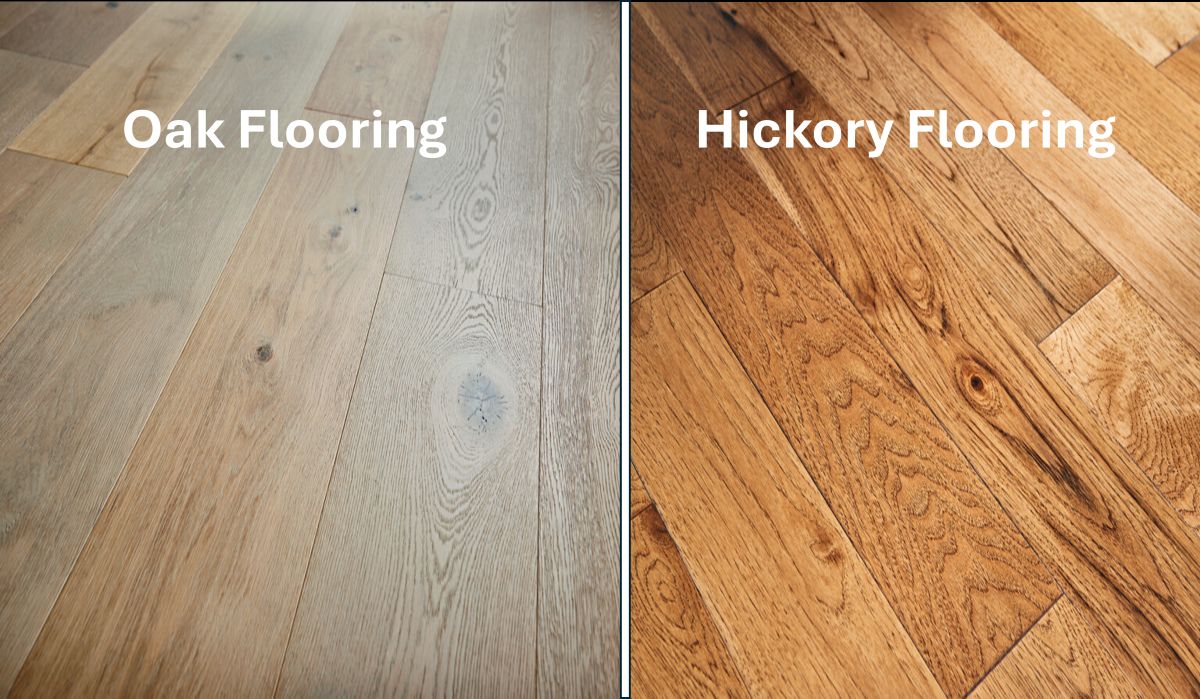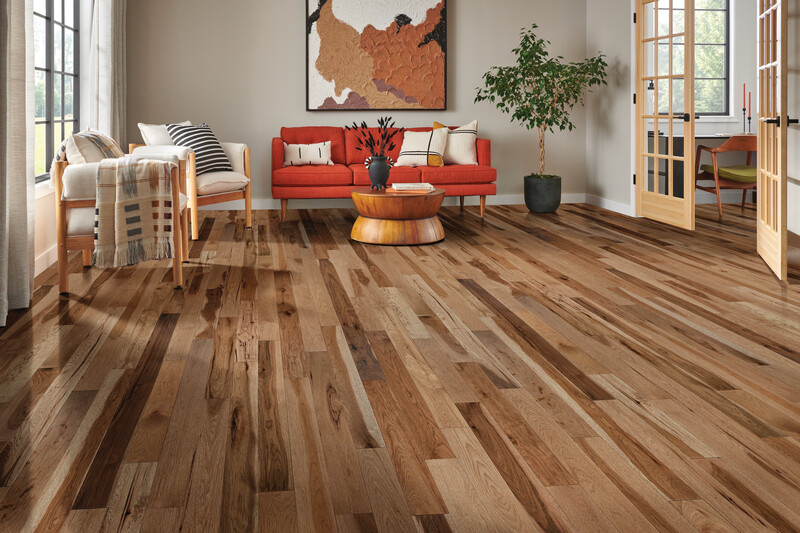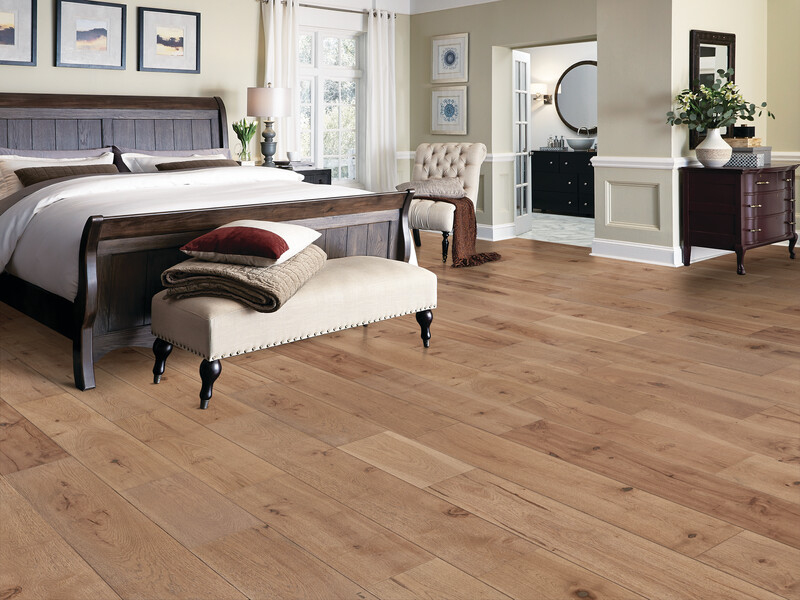Hickory Wood Floors vs Oak – Which to Choose
May 8, 2025
Few choices in hardwood flooring have stood the test of time quite like oak and hickory. Both are time-honored species that bring lasting character to American homes. But when it’s time to choose between them, which one delivers the right mix of beauty and performance for your space?
Let’s see if we can help you with that decision. We’ll walk you through the key differences between oak and hickory hardwood floors. So get ready to learn more about everything from color and grain patterns to durability, scratch resistance, and cost.

Hickory and Oak Flooring at a Glance
Let’s start with a high-level summary before diving into the details. The chart gives a side-by-side snapshot of how hickory and oak hardwood floors stack up. From strength and appearance to cost and versatility, here’s what to expect from each wood species:
| Feature | Hickory | Oak |
| Color Variation | Wide-ranging, bold contrasts | Consistent, understated tones |
| Grain Pattern | Varied, knotty, pronounced | Linear, smooth, more uniform |
| Hardness (Janka Scale) | 1820 (among the hardest domestic woods) | White Oak: 1360, Red Oak: 1290 |
| Dent/Scratch Resistance | Excellent | Moderate |
| Cost | Typically higher | Usually more budget-friendly |
| Best Fit | Rustic, high-traffic homes | Traditional, modern, flexible styles |
Grain Pattern: Complexity vs. Consistency
Grain isn’t just what you see—it’s what you feel, and how a floor brings a room to life. It plays a defining role in the visual texture of your hardwood.
- Hickory features intense, complex grains with visible knots and streaks. No two boards look alike, making it ideal for homeowners seeking natural variation and a bold statement. Personality defines hickory flooring.
- Oak, particularly white oak, displays a smoother, straighter grain that gives it a timeless, structured appearance. Red oak has slightly more visible grain but maintains a classic feel. Oak’s more subtle texture is a go-to for traditional and contemporary interiors.
Color: Hickory’s Boldness vs. Oak’s Balance
Color is one of the most noticeable and influential features of hardwood flooring. It sets the tone for the entire room and impacts how light interacts with the space and how furnishings come together.

The color variations between hickory and oak are considerable. They play a major role in the overall vibe of your home.
- Hickory flooring features a color range—creams, tans, browns, and even reddish tones may appear side-by-side in a single plank. You can define its color using one word – bold. So, hickory delivers with character if you’re after a dynamic, rustic, or lived-in look.
- Oak flooring—whether white oak or red oak—leans more uniform. White oak offers a cooler palette with subtle beige, light brown, or gray undertones. Red oak, by contrast, brings warmth with its reddish hues. For flooring that plays well with a broad palette of furniture and decor, oak’s steady tone fits the bill.
The Scratch Test for Hickory and Oak
Durability isn’t just about day one—it’s about year 30, too. You want your floors to look impeccable even after years of wear and tear. How well they hold up to scratches is one benchmark.
- Hickory is a dense wood that holds up well over time. It owns a high hardness score (more on that in a second). That allows it to resist damage from pets, furniture, and kids better than most.
- Oak hardwood floors also offer long-term value. Though slightly softer, they’re easy to sand and refinish, extending their usable life for decades. Both red and white oak age gracefully and develop character as they wear.
With proper care, either species can last 30 years for starters. Some companies, like Robbins®, offer a lifetime warranty on their Natural Forest™ hickory and oak flooring collection. The flooring uses trees harvested in the Appalachians and manufactured in U.S. plants.
Hickory vs. Oak for Hardness
Hardwood floors must stand up to life. That’s where hardness comes in. Rolling furniture, dropped toys, or foot traffic test your floors daily. The strength of your flooring determines how well it resists wear and tear.
In the hickory vs. oak showdown, one species takes the top spot for toughness measured by the Janka hardness scale.
Hickory scores 1820 on the Janka scale, putting it at the top of the hardest domestic hardwoods list. That makes it highly resistant to dents and scratches. And that’s a massive advantage for high-traffic areas like kitchens and living rooms.
White oak is 1360, and red oak is 1290. While not as hard as hickory, each still performs well and handles daily wear gracefully, especially when maintained properly.

What’s the Cost Difference?
The hickory vs. oak flooring cost depends on finish, grade, and installation method. Generally, here’s what typical pricing looks like:
| Flooring Type | Material Cost (per sq. ft.) |
| Hickory | $6 – $14 |
| White Oak | $5 – $12 |
| Red Oak | $5 – $12 |
(Source: Bankrate)
Hickory generally commands a higher price because of its durability and distinctive look. Oak, especially red oak, is widely available and often more affordable.
Which Is Right for Your Home?
Choosing between hickory and oak hardwood flooring depends on your lifestyle, style preferences, and budget.
Hickory stands out if you love rustic charm, need top-tier scratch resistance, or want a floor that turns heads. No other domestic hardwood offers quite the character of hickory.
Conversely, oak delivers a timeless, adaptable look that works across various design styles and won’t break the budget. There’s a reason it’s the most popular flooring selection in the U.S.
Robbins® offers both options backed by American craftsmanship. You can select from solid or engineered hardwoods in numerous styles and finishes. You can even have extra-wide planks that are 7″ or more.
Find the Robbins dealer nearest you today and decide – hickory or oak!
FAQ: Hickory vs Oak Flooring
Q: Is hickory better than oak for high-traffic areas?
A: Yes. Hickory’s higher Janka rating makes it more resistant to dents and scratches and is ideal for spaces with heavy foot traffic, pets, or kids.
Q: Which wood lasts longer—hickory or oak?
A: Both can last decades with proper care. Hickory is harder, but you can easily refinish oak to extend its lifespan.
Q: Can I stain hickory or oak flooring?
A: Yes, however, oak tends to take stain more evenly due to its grain uniformity. Hickory’s variation may result in a more mottled look.
Q: Is oak flooring cheaper than hickory?
A: In most cases, yes. Oak—especially red oak—is more widely available and typically less expensive than hickory.
Q: Do both hickory and oak come in engineered options?
A: Absolutely. Robbins offers engineered hardwood options for both species, giving you flexibility in installation and style.
